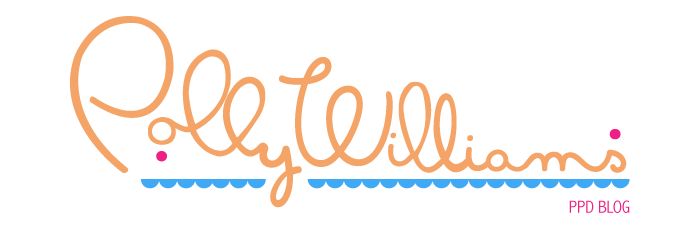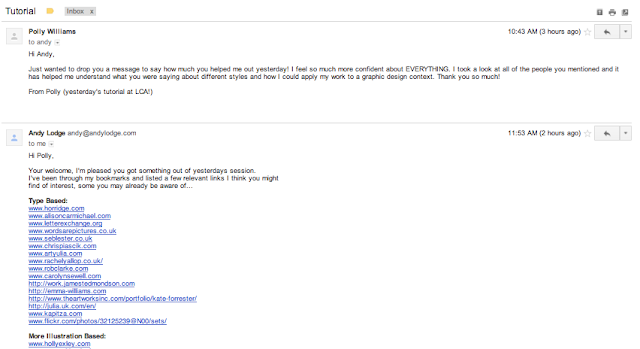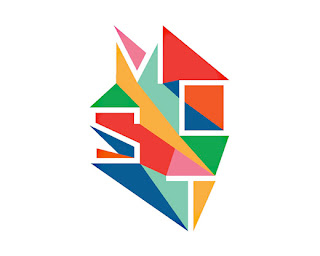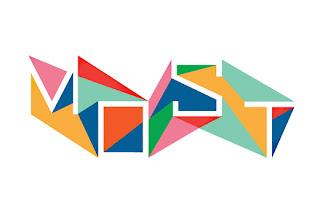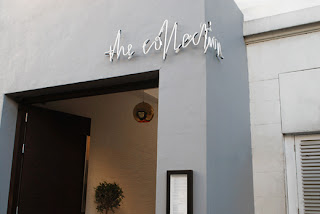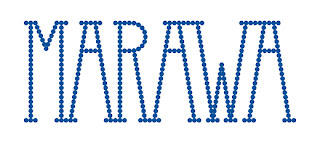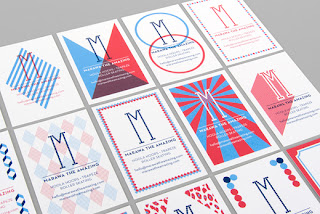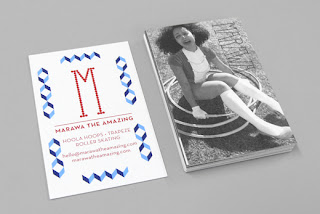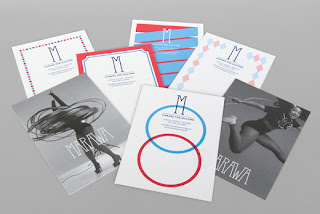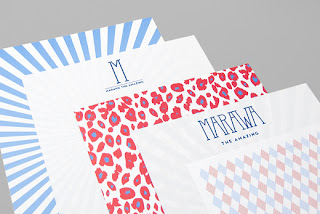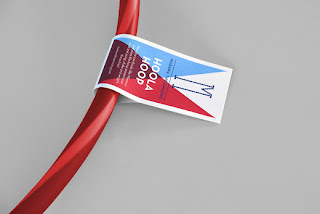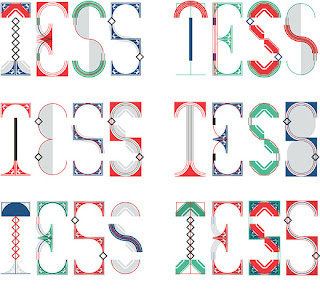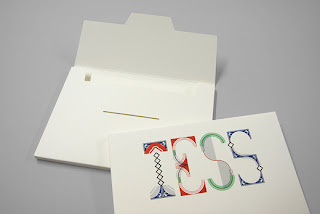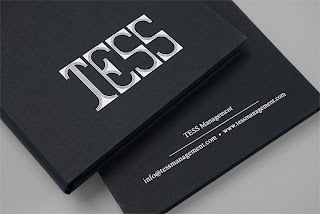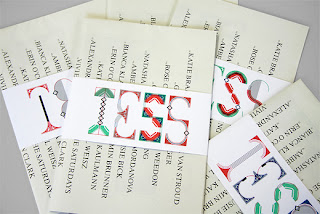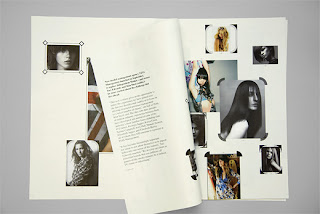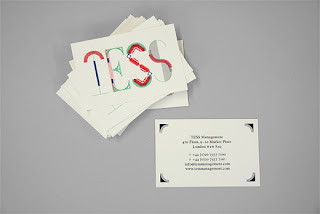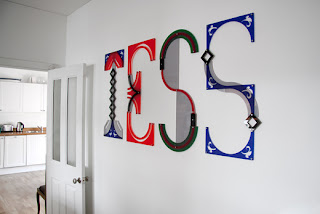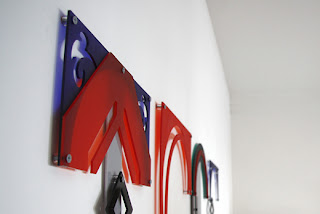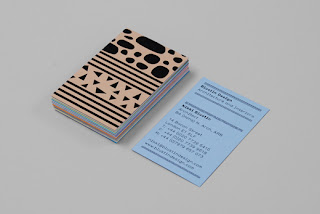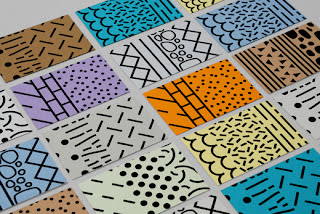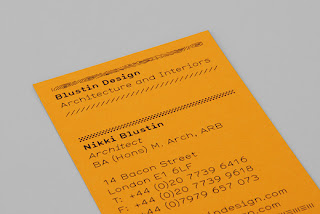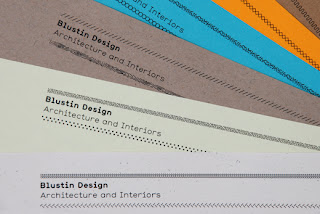I had a fantastic tutorial with Andy Lodge yesterday. He really helped me with my action plan for the next few months following the decisions I have made in light of my recent placement. I sent him a thank you email and he sent me some links which I cant wait to have a look at.
Wednesday 29 February 2012
Tuesday 28 February 2012
Friday 10 February 2012
Studio EMMI

Emmi Salonen — Studio EMMI
DESCRIBE THE IDEAL CANDIDATE IN THREE WORDS
TALENTED
HUMBLE
POSITIVE
HUMBLE
POSITIVE
WHAT’S THE BEST WAY TO GET NOTICED AT APPLICATION STAGE?
A neat presentation, with attention to detail and a short and sharp covering letter. Whether a PDF or printed portfolio, the layout should have character and feel like time and care has gone into putting it together. No spelling mistakes, no widows, no hyphenations or strange line endings.
WHAT’S THE MOST COMMON MISTAKE PEOPLE MAKE WHEN THEY APPLY FOR JOBS?
Talking at length about themselves and forgetting to mention why they would like to work in the chosen studio.
Also, although it is a creative industry, it’s still a job application and should be treated with equal formality.
HOW IMPORTANT IS IT FOR YOU TO SEE PERSONAL WORK?
Depends on the candidate’s experience. It’s always good to ‘top up’ the portfolio with personal work, if you feel something is missing. But for me, it’s not vital. It’s much more important that the portfolio corresponds to the type of work my studio produces, showing good examples of logo, identity system and layout design.
WHAT’S THE ONE THING A POTENTIAL EMPLOYEE CAN DO THAT WILL IMPRESS YOU?
Present a solid portfolio with confidence but not a hint of arrogance.
IS IT POSSIBLE TO TRY TOO HARD?
Yes. Be yourself and work hard. But too much of anything is too much.
ABOUT STUDIO EMMI
Studio EMMI is a London based graphic design practice. Our particular speciality is the creation of environmentally conscious solutions to identity and print design.
Established in 2005, we have had the pleasure of working with local and global brands on marketing campaigns, exhibitions, events and publishing projects. Over the years we have developed a track record and a long list of happy clients from the worlds of art, culture, commerce, retail and academia. These include Tate Britain, The Prince’s Foundation for Children & the Arts, Artek and Thames & Hudson.
While our clients continue to define us, at the core of Studio EMMI is a strong set of values. Embracing ethical design, combined with environmental awareness and positive attitude, we also pride wit, openness and mastered craftsmanship in our work.
Studio EMMI is run by Emmi Salonen. Alongside Emmi there is a group of trusted associates on standby, ready to lend their expertise depending on the needs of the project.
Thursday 9 February 2012
David Pearson Design

David Pearson — David Pearson Design
DESCRIBE THE IDEAL CANDIDATE IN THREE WORDS
POLITE
ATTENTIVEINTERESTED
ATTENTIVEINTERESTED
WHAT’S THE BEST WAY TO GET NOTICED AT APPLICATION STAGE?
In many ways, it’s to not try and get noticed. By that I mean that it’s important to not tell people exactly why they should hire you. Rather, you should present them with enough information to arrive to the decision themselves. This seems like an obvious thing to point out but a little humility can go a long way, especially considering that an employer is looking for a personality that they would be happy to spend their day around.
HOW IMPORTANT IS IT FOR YOU TO SEE COMMERCIAL WORK?
Although proof of commercial work can provide a sense of a candidate’s ability to time, budget and personality manage, there’s really no reason why a portfolio made entirely of personal projects shouldn’t be enough. The work has to be good, whichever way you look at it.
WHAT’S MORE IMPORTANT, EXPERIENCE OR ENTHUSIASM?
Enthusiasm. An enthusiastic and enquiring individual will develop at a rate of knots and fast leave behind someone believing/who believes they are the finished article.
WHAT'S THE WORST THING THAT YOU CAN DO IN AN INTERVIEW?
Look bored. To come across as aloof, complacent, or to have failed to plan in any way will mean you’re going to have a very hard time convincing someone of your merits. As an interviewer, it is essential that you can detect a spark behind the eyes and get a sense of it being just a bit more than a job to the interviewee.
IS IT POSSIBLE TO DO TOO MANY INTERNSHIPS?
Perhaps. I think it really depends on the personality of the individual but speaking personally, I don’t think my constitution would support a succession of people allowing me to walk out of the door!
That said, you can never underestimate the power of putting yourself in and around the industry. Making contacts is such an invaluable endeavour and will always lead to new opportunities.
ABOUT DAVID PEARSON DESIGN
I previously worked in-house at Penguin Books—as typographer and later, cover designer—before leaving to set up my own studio in 2007. I now work largely as a sole trader but employ illustrators, photographers and lettering artists on a job-by-job basis.
Current clients include: Cormac McCarthy, Nigel Slater, Alain de Botton and William Shakespeare.
Wednesday 8 February 2012
Studio Frith

Frith Kerr — Studio Frith
DESCRIBE THE IDEAL CANDIDATE IN THREE WORDS
BRIGHT
POLITE
PUNCTUAL
POLITE
PUNCTUAL
HOW IMPORTANT IS YOUR CV, COMPARED TO YOUR PORTFOLIO?
Both are important.
HOW IMPORTANT IS IT FOR YOU TO SEE PERSONAL WORK?
It’s super-important to see work that isn’t undertaken at another studio (alongside any studio work), so that we can get an understanding of that person’s particular interests and passions.
WHAT’S THE MOST COMMON MISTAKE PEOPLE MAKE WHEN THEY APPLY FOR JOBS?
Writing a generic email, and starting with ‘Dear Sir’.
WHAT’S THE ONE THING A POTENTIAL EMPLOYEE CAN DO THAT WILL IMPRESS YOU?
Our last intern baked us a cake to say thank you.
IS IT POSSIBLE TO DO TOO MANY INTERNSHIPS?
Yes and no. In this economic climate it is easily done, and it is not necessarily a reflection on the candidate's abilities. Ideally, internships should be a short term undertaking, with the view of letting the internee get a good insight and working knowledge of their chosen discipline and that particular company—perhaps finding out what they don’t want to do, as much as what they do, and who for.
ABOUT STUDIO FRITH
Studio Frith is a new graphic design consultancy set up by Frith Kerr after 11 years as a director and partner of the highly acclaimed Kerr/Noble. "Britain has continued to produce—and educate—some of the world’s leading designers: Kerr/Noble in graphic design..." Alice Rawsthorn, International Herald Tribune.
Studio Frith collaborates with a mix of corporate and cultural clients. These include: Artangel, Chisenhale Gallery, David Chipperfield Architects, Gallery Libby Sellers, Hussein Chalayan, Melrose & Morgan, Plain English, Rizzoli, Serpentine Gallery, Somerset House, Studioilse, Victoria & Albert Museum and White Cube.
Current projects include: identity for a private guest house in Stockholm with StudioIlse; a book on the drawings of Lucian Freud; an upcoming publication for Visual Editions written by Adam Thirlwell.
Tuesday 7 February 2012
Someone

Simon Manchipp – SomeOne
DESCRIBE THE IDEAL CANDIDATE IN THREE WORDS
TALENTED
TALENTED
TALENTED
TALENTED
TALENTED
WHAT’S THE MOST COMMON MISTAKE PEOPLE MAKE WHEN THEY APPLY FOR JOBS?
They don't make it personal, professional or powerful.
HOW IMPORTANT IS IT FOR YOU TO SEE COMMERCIAL WORK?
It's important to prove that you can apply lateral thinking to literally anything. There's no point in showing a black and white logo on a white page—branding is all about context, so give it a context. But a beautifully considered project about mapping the streets of BoraBora would impress as much as a kick-ass approach to rebranding Greggs the Baker.
DOES IT MATTER WHAT YOU WEAR TO AN INTERVIEW IF YOUR PORTFOLIO IS STUNNING?
Not really. But it helps if you look presentable. We don't have a uniform, but we are tribal and like people who fit into our gang. A suit is a no-no—but it wouldn't put us off (we've had it before and just told them, you're hired, so relax!). But looking like a bag of chips is never going to aid and abet your quest. Be yourself. Unless yourself is a hardcore techno-goth, then tone it down... know your audience!
Steve Jobs tells the story (in his biography) of how he turned up at Atari fresh from a recent pilgrimage to India, dressed in full Indian garb with bare feet and unwashed and said, "Hi, I'm Steve, I'm not leaving 'till you give me a job". He had the extremely unusual raw talent to pull it off, even though he smelled so bad they made him work the nightshift. This immense talent is very rare and this approach would repel most employers—so don't think you can do this. If you do think you can do this, you should probably be starting your own company—not trying to join one.
WHAT’S WORSE — OVER OR UNDERSELLING YOURSELF?
Both bad—but no one likes a cock-sure 21 year old (just look at the Apprentice for wise-cracking swagger-merchants). Better to be modest and let the work sing—a good creative director will see the work and praise. 'Gently persistent' is probably the best way to approach things. Be like water, everywhere and persistently eroding barriers.
WHAT’S THE ONE THING A POTENTIAL EMPLOYEE CAN DO THAT WILL IMPRESS YOU?
Be an instant asset, not a cost—by this I mean come in with a 'can-do' entrepreneurial attitude where you know what you are good at, demonstrate it elegantly and swiftly and make your offer seductive enough to be hard to ignore. Employers want someone who can make stuff significantly better, without incurring significant costs—from day one. Be that person, and you will soon become invaluable and climb the ladder rapidly.
ABOUT SOMEONE
We are 30 people in a room.
Started, run and owned by three creative directors.
SomeOne is a London design practice that launches, relaunches & protects brands.
Unlike large, traditional groups, working with SomeOne means clients meet and work with the designers. After all, that’s why we get hired. To design.
Direct contact with SomeOne’s creative minds means ideas flow more freely, which is important as great brands need great opinions.
Ideas excite us, they shape the future, add value & signal change.
That’s why we concentrate on big ideas first, then go about making them beautifully.
Monday 6 February 2012
Browns

Claire Warner — Browns
DESCRIBE THE IDEAL CANDIDATE IN THREE WORDS
BRIGHT
PASSIONATE
KEEN
PASSIONATE
KEEN
WHAT’S THE BEST WAY TO GET NOTICED AT APPLICATION STAGE?
Tailor your folio and make sure it's relevant. Every company looks for different qualities in a designer, so do your research. At Browns the first thing we look for is great ideas, beautiful design and typography, knowledge of craft, production values and moving image, plus an understanding of modernist rigour with the ability to break the rules and have some fun. But this is not enough, there are lots of good designers out there who can do this.
To stand out from the crowd you also need to show that you can apply that to a mixture of culture and commerce. A folio full of conceptual posters or books with self-initiated briefs, may look beautiful, but doesn’t show your ability to solve problems and answer a client brief. Likewise, a folio full of very commercial work may not show enough of ‘you’.
To stand out from the crowd you also need to show that you can apply that to a mixture of culture and commerce. A folio full of conceptual posters or books with self-initiated briefs, may look beautiful, but doesn’t show your ability to solve problems and answer a client brief. Likewise, a folio full of very commercial work may not show enough of ‘you’.
For us, the perfect folio is one that shows you are flexible and can apply yourself to any project, large or small, print or digital. Today more than ever there is a need for designers to be multi-talented across all media, so an edit of work including identity/branding, editorial, books, posters, digital/moving image goes a long way.
WHAT’S THE MOST COMMON MISTAKE PEOPLE MAKE WHEN THEY APPLY FOR JOBS?
Its important to find out who to send your folio to. A generic application without a name comes across as lazy and often ends up in the bin. A quick phone call to get the right name and email address can avoid this.
Spelling mistakes are another common blunder. When applying for a job working predominantly with type, a spelling mistake is suicide. I’ve seen ‘design’ spelt wrong on someone’s CV—which doesn’t say much for attention to detail.
Keep your covering email concise. Too long and you risk losing interest. Too short and it looks like you haven’t tried. Be clear about what you are applying for, internship, freelance or permanent and show an interest and understanding of the company’s work, its not all about you.
This sounds simple, but make sure your PDF is no bigger than 8-10MB and the images are not pixellated. You’d be surprised at how many PDFs we receive where you can hardly see the work due to compression.
In my opinion, 6-12 projects is about right for a PDF folio. 3-4 is not enough to get a good picture of your skills, unless you back it up with more work on a website.
DOES IT MATTER WHAT YOU WEAR TO AN INTERVIEW IF YOUR PORTFOLIO IS STUNNING?
Not really, but clothes can be a window to who you are as a person. A hoody and scruffy trainers sends a very different message from a Shoreditch trendy with a tweed jacket and bow tie. It’s important to be yourself—we employ the person, not just the folio and it’s important that people fit into the dynamic of the studio.
WHAT’S THE ONE THING A POTENTIAL EMPLOYEE CAN DO THAT WILL IMPRESS YOU?
Being able to talk confidently, without arrogance, about your influences and inspiration. Show your knowledge and passion by having an opinion about the design industry, past and present. Do your research and understand where Browns work fits into that and what you think you can bring to the table.
IS IT POSSIBLE TO DO TOO MANY INTERNSHIPS?
Yes. There isn’t a magic number, but between 1-5 internships at respectable companies looks great on a CV. Many more than that and I would start to wonder why no-one else snapped you up sooner. The problem is, its tough out there at the moment, there aren’t many permanent jobs available, and I’m a firm believer that its much more pro-active to do internships and meet people than to sit at home doing nothing. The more people you meet and stay in touch with, the more likely you are to be recommended when a permanent job does become available. Saying that, there comes a point when you should be aiming for junior freelance positions rather than internships.
ABOUT BROWNS
Browns is an independent design studio based in London Bridge, founded in 1998. The studio is run creatively by founder Jonathan Ellery together with myself. We currently have 8 permanent members of staff plus we always have an intern from around the world. We work with a wide variety of clients, large and small.
The studio also has its own publishing house, Browns Editions, which, since its founding in 2005, has designed and published a wide variety of art and photography books.
Sunday 5 February 2012
Mind Design
Mind Design are a small studio based in London. I came across them through reading their opinions on the ideal graduate/intern as part of It's Nice That's month of advice for students. I absolutely love their work and wish that I had come accross it sooner as I think it will indfluence my practice considerably. They work with branding across print, web and interiors. A lot of their work is image driven, featuring pattern or other illustrative elements. The application to interior spaces is what makes them stand out for me, and this is definitely something that I want to consider with my application of illustration to my future projects. Especially with log designs, making them 3d and the introduction of textures and surfaces really brings them to life.
This first example is for MOST, a new major showcase for design at the upcoming Milan Design Week. This shows custom lettering applied to logo design - which in this case, is a really appropriate style.
www.marawatheamazing.com
Identity for a a new London based model agency which evolved from Independent Talent. Tess represents well established names such as Naomi Campbell and Erin O'Connor in the UK. The identity uses several logo variations based on a modular system of art-deco inspired elements. The same elements are being used for frames which overlap images of the models on various printed applications as well as on the original website.
With a very small budget they designed the identity and stationery for this architecture and interior practice based in East London. The design is inspired by architectural hatch patterns which are used to distinguish different building materials. As most of the communication will be printed in-house on the client's own printer it was important that the design was economical and easy to reproduce. They encourage the client to change the paper stock as often as possible.
This first example is for MOST, a new major showcase for design at the upcoming Milan Design Week. This shows custom lettering applied to logo design - which in this case, is a really appropriate style.
The Collection is a restaurant, cultural event and retail space they collaborated on with Tom Dixon. They designed the identity, signage system and all printed material.
The idea for the identity relates to multiple prints, limited editions and artist signatures. The execution is relatively simple: Everything is based on an A5 format with punched holes. They used screen printing which allowed them to change colours on the printing bed and makes each print unique. Larger signs are made up by several A5 boards and the thickness is achieved by hanging several signs in front of each other. For the logo they asked the client to write the name in their own handwriting connecting two dots equivalent to the punched holes.
Identity for Marawa The Amazing, an international Hoola Hoop star and performer. The logo is based on the signage of old revue theaters which often use light bulbs. The stationery is printed in 3 colours and every business card is different. They also designed the graphics for an i-phone app and are currently working on the website as well as tags for hoops.
www.marawatheamazing.com
Tess Management
Identity for a a new London based model agency which evolved from Independent Talent. Tess represents well established names such as Naomi Campbell and Erin O'Connor in the UK. The identity uses several logo variations based on a modular system of art-deco inspired elements. The same elements are being used for frames which overlap images of the models on various printed applications as well as on the original website.
Magpie studio

Jamie Ellul – Magpie Studio
DESCRIBE THE IDEAL CANDIDATE IN THREE WORDS
BRIGHT
GROUNDEDKEEN
GROUNDEDKEEN
HOW IMPORTANT IS YOUR CV, COMPARED TO YOUR PORTFOLIO?
Personally I'm more interested in how a designer thinks than where they did their thinking. So for me it's all about a portfolio of 'wish I'd thought of that' ideas with a reasonable execution (Mac skills and typography can be taught, but natural creativity can't). Of course I'll still look over someone's CV prior to seeing their portfolio—it's no surprise that the better designers tend to have done well in non-creative subjects at school too, providing them with better copywriting skills, literacy and general knowledge.
And of course the layout of the CV is a biggy—if a designer can't design and lay out their own CV, then how are they going to lay out a beautiful 64 page book? CVs in Word are a big no no—they need to be simple, easy to read and well laid out. First impressions count.
HOW IMPORTANT IS IT FOR YOU TO SEE COMMERCIAL WORK?
I'm in two minds about this—at Somerset College we were given very commercial briefs which led to us leaving with a creative and very 'employable' portfolio. But since setting up Magpie we've employed two graduates from Kingston whose portfolios were less commercial and more conceptual in an arty way. Their work was very considered but there weren't any logos or classic print projects—in its place were amazing stop frame animations and bonkers 8ft pencils. But when they applied their thinking to commercial projects we found they came up with exciting and unexpected results.
So my stance has changed slightly—or perhaps a halfway house is what's needed? Groundbreaking, unexpected ideas applied to commercial briefs—which is essentially what we're all trying to do in the industry isn't it?
IS WHAT YOU DO IN YOUR SPARE TIME IMPORTANT OR IRRELEVANT?
It's so important. I'm very much of the opinion that designers who are obsessives and live and breathe design are missing out on the other bits of life that can inform their aesthetic and thinking. We've got musicians, bakers, boxing fanatics, culture vultures, illustrators, photographers, stamp collectors, footballers and Dads at Magpie. And it's all the better for it. Too much work and no play makes a magpie a dull bird.
WHAT’S THE ONE THING A POTENTIAL EMPLOYEE CAN DO THAT WILL IMPRESS YOU?
It's all pretty obvious, common sense stuff but enthusiasm is key. If someone acts like they want to work for you then you're more inclined to consider them. Apart from our senior designer Tim, all of our designers have joined us following extended work placements. What made them stand out was their attitude; keen to work on anything including the mundane parts of the job, keen to impress with their ideas (even if they weren't quite on brief) and keen to learn new things.
HOW IMPORTANT IS IT FOR A CANDIDATE TO FIT IN WITH YOUR COMPANY CULTURE?
It's 50% of what it takes to be successful. Design agencies are usually pretty small or at least divided into small teams. So working closely with seven or so people for 10 hours a day every week in what can be an intense creative environment takes a certain kind of person. At Magpie there's no room for egotistical big heads—the idea is king and it doesn't matter who comes up with it, we'll push the best idea forward. So the people that work with us are all fun, hardworking, talented and above all nice folk. I don't dread going to work on Sunday nights like I sometimes used to before Magpie—and that's because we've chosen people we like to work with (and of course we have some great forward thinking clients too). You can be the most talented designer out there, but if you don't get on with people on a day-to-day basis then you'll never get a job. And this obviously includes clients, without whom there wouldn't be a design agency. Clients don't like uppity, over-precious designers and nor do we.
One last thing which has probably been my one consistent tip over the past 10 years of viewing graduate portfolios is this—it's just as important to know what you don't want to do as what you do. Sometimes taking placements at companies you don't think you want to work at helps cement in your mind what kind of company you don't want to work within. I did a placement at a large packaging agency on graduating—although I liked the people the work was dull and I decided that the kind of work they did wasn't for me. I even turned down a job there because I knew I'd be miserable. My footnote to this is if you are doing a placement you hate, still be keen and professional—the design industry is tiny and everyone knows each other. Someone there will know someone in a company where you do want to work and that could be your in.
So, in the words of Anthony Burrill: "Work Hard and Be Nice to People".
ABOUT MAGPIE STUDIO
Magpie was founded in 2008 by David Azurdia, Ben Christie and Jamie Ellul with a clear intention of producing beautifully crafted, ideas-driven design.
The three directors met whilst studying at Somerset College of Arts in the late 90s. After graduating, they migrated to London and spent 10 years honing their skills, independently, at some of London’s top branding agencies, in both a full time and freelance capacity.
The studio has now grown to seven full time staff and a host of collaborators, working in a diverse range of media with a diverse range of clients including BAFTA, The British Heart Foundation, Channel 4, D&AD, Houses of Parliament, Land Securities, Robert Horne Paper, Royal Mail and University of the Arts.
Saturday 4 February 2012
Mind Design

Holger Jacobs — Mind Design
DESCRIBE THE IDEAL CANDIDATE IN THREE WORDS
A
NICE
PERSON
NICE
PERSON
WHAT’S THE BEST WAY TO GET NOTICED AT APPLICATION STAGE?
Obviously a good portfolio with a focus on typography helps. We look at every detail, for example the spacing of phone numbers and the correct use of dashes between the years in the CV. Everyone in our studio is entirely responsible for his own work. If someone makes basic typographic mistakes me or my colleagues would have to check everything before it goes to print. So that's the basics. Apart from that we are looking for personality in the work. Nowadays there is so much design around, in books magazines and on blogs. It’s hard to do something that hasn't been seen before. The work we are looking for must be honest and with passion, not something that follows a certain style or recent trend.
HOW IMPORTANT IS IT FOR YOU TO SEE COMMERCIAL WORK?
There is a difference between 'commercial' and 'applied' work. 'Commercial' always sounds compromised in some way. We are often trying do applied work in an uncommercial way.
If a portfolio is full of 'commercial' work it is hard to see the personality behind it. Instead we see the agency, the expectations of the client, the corporate guidelines, the market research and the focus group. On the other hand, if a portfolio only consists of self-initiated projects and bits of self-publishing it is hard to imagine how the applicant would ever work with a real client who might only be interested in increasing his sales. A good designer should be able to control a process in which the outcome answers the client's needs but also matters in a wider design context.
WHAT’S WORSE — OVER OR UNDERSELLING YOURSELF?
Definitely overselling. Designers need to be self-critical, confident and convincing, but also be able to listen to others and admit their mistakes. If a design doesn't 'feel' right, it is usually impossible to sell it to a client.
IS IT POSSIBLE TO DO TOO MANY INTERNSHIPS?
It certainly is. I have told designers, applying for internships in the past, that they are far too good and should go on holiday rather than doing another internship. Or start their own studio if they have graduated already. If someone keeps doing one internship after another and then applies for a job you wonder why he or she has not been offered to stay anywhere permanently before. It makes you suspicious. Although I understand very well that it is hard to find permanent work nowadays, especially in small studios. The problem might be that the work featured in the design press is often produced by small independent studios of just a few people. However, those studios rarely employ new staff as they prefer to remain small.
HOW IMPORTANT IS IT FOR A CANDIDATE TO FIT IN WITH YOUR COMPANY CULTURE?
Very important. It is probably the most important criteria of all. I spend a lot of time with my colleagues in the studio, probably more than with my wife. A consistently good working atmosphere influences the outcome and is much more important than making big profits or rushing from one project to the other. We have seen quite a few designers in interviews who seem to work mostly for their own portfolio. They are often extremely good but never stay with a studio for long. If there is no interesting project for a while they move on. This approach doesn't work for us. If work dries up we all would look for new projects, or if there is something really boring to do for a while we would all struggle through it. Equally nobody gets fired if money is tight. Thinking long term and as a team is crucial.
However, without wanting to discriminate, we would look for someone who lives in East London, rides a bike, has a good sense of humor, joins us for a drink in the local pub, has some attitude and is certainly not a hippie.
ABOUT MIND DESIGN
Mind Design are Claire Huss, Holger Jacobs and Romilly Winter. We are an independent graphic design studio in East London. Mind Design focuses on integrated design which combines corporate identity, print, web and interior design. We work for a wide range of clients across various sectors; from startups to established companies. Our philosophy and approach is based on a passion for craftsmanship and typography. We offer practical and friendly design solutions and believe that content and form are inseparable. Every project is seen as a new challenge and we never follow an already established graphic house style.
Friday 3 February 2012
Fivefootsix

Algy Batten – Fivefootsix
DESCRIBE THE IDEAL CANDIDATE IN THREE WORDS
PASSIONATE
ENTHUSIASTIC
ALERT
ENTHUSIASTIC
ALERT
HOW IMPORTANT IS YOUR CV, COMPARED TO YOUR PORTFOLIO?
A good CV may help you get attention in the first instance, especially if you have worked at, or had placements with good agencies. But the typographic attention to detail in the CV can often let people down, and a lot of candidates now feel the need to 'jazz' up the CV and over-design it. But as we all know good design can be as much about what you decide to leave out as well as put in. Personally I prefer a very clear, concise CV, and the same goes for the portfolio. I think the work should be what stands out.
But to be honest, the portfolio PDFs that we are sent are generally where I look first (assuming I've been sent both), then if the work excites me I'll look at the CV to check their experience; as long as it's not in Word!
We're actually recruiting for a middle weight and senior designer at the moment and, ironically, even though there is probably a greater wealth of info on the CV at that stage in one's career, it's still the portfolio I'm more interested in
WHAT’S THE MOST COMMON MISTAKE PEOPLE MAKE WHEN THEY APPLY FOR JOBS?
I'm not sure I'm aware of a common mistake people make when applying for jobs, but a generic email that looks like it's had the send button hit numerous times does't usually get a response. I have had a few of those where they've forgotten to change the name too!
As for during the interview itself, I believe a little bit of attention to your personal presentation is still relevant even in today's more relaxed environment. We had one chap turn up chewing gum, not the end of the world perhaps, but in talking us through his portfolio it shot out of his mouth and landed on his laptop! Maybe only Alex Ferguson should be allowed to chew gum in a professional arena?
WHAT’S WORSE — OVER OR UNDERSELLING YOURSELF?
I would say overselling is worse than underselling. Overselling, if your design skills can't live up to the promise suggested by 'your' portfolio, will always end in disappointment for both parties. If someone joined us through overselling it would soon become apparent, and then everyone's time has been wasted. If you undersell, the work speaks for itself, and will do the selling for you. By underselling I don't mean having a poorly produced portfolio though, there's no excuse for that.
WHAT’S THE ONE THING A POTENTIAL EMPLOYEE CAN DO THAT WILL IMPRESS YOU?
I'm always impressed by people who are eager to improve themselves. As designers we should never stop learning and developing our skills, we should be as passionate about this as when we were at college. Although these days for me it's my business skills as much as the design that I'm learning about, and so this year I'm sending myself to Cranfield School of Business. Watch this space Richard Branson!
DO YOU EVER GIVE FEEDBACK ON INTERVIEWS?
Would I give feedback on interviews? Yes if asked, but if there was something that really stood out that we thought would benefit that candidate in the future we would definitely say something. I think it's important to be honest. In today's world we can all be a little too tactful and it doesn't always benefit, and if delivered with a little compassion talking straight can be much more positive. I think Noel Gallagher has a good quote on that, but I can't remember it…
ABOUT FIVEFOOTSIX
Fivefootsix is an independent design consultancy of 9 people founded by Directors Algy Batten and Mark McConnachie in 2005. We're based in London and we work across a diverse range of sectors, including, retail, technology, leisure and charities, providing creative solutions across a broad range of disciplines such as brand identity and communications, print, packaging, environmental and web design.
We have worked with household names like Ben & Jerry’s, Nokia, Yahoo!, PlayStation, Unilever and the BBC, as well as start-ups, boutique businesses and charities. In addition, we have substantial experience working with professional organisations and corporations including the European Bank for Reconstruction & Development (EBRD) and University Partnerships Programme (UPP).
Thursday 2 February 2012
The ideal candidate (2)

Steve Teruggi and Corinna Drossel — Winkreative
DESCRIBE THE IDEAL CANDIDATE IN THREE WORDS
INFORMEDORIGINAL
FAST
FAST
WHAT’S THE BEST WAY TO GET NOTICED AT APPLICATION STAGE?
Send us a portfolio of work that shows an understanding of our company culture and aesthetic preferences, together with an engaging letter that shows thoughtful emotion about your desire to work with us. Extra credit is given to those delivering a printed portfolio piece rather than digital, especially if it is a bespoke production just for us rather than a generic portfolio that was clearly sent to a dozen agencies.
HOW IMPORTANT IS IT FOR YOU TO SEE COMMERCIAL WORK?
Essential. Our design team all meet and present to our clients, so must understand the commercial issues that govern client decision making. Appreciation of the value, feasibility and target audience benefits of their design work to brands is what gets work through approval processes. This is often the difference between great design that lives in a presentation and great work that actually becomes realised for public consumption.
For junior candidates this is equally important. We appreciate a good balance of self-initiated and commercial portfolio work. The commercial work proves how candidates consider specific target markets. The self-initiated work tells us about a designer's motivation and personal interest in the field of design, their dedication and sense of craft. Do they know about bookbinding techniques, can they produce beautiful mock-ups, can they use materials in a tactile and seductive way? How imaginative is the realisation of a specific idea? All these skills are imperative to being a good designer in our environment.
IS WHAT YOU DO IN YOUR SPARE TIME IMPORTANT OR IRRELEVANT?
Very important. It is highly representative of character and personal development. Inspiration originates from many places, so spare time activity says a lot about a candidate's potential fit in our studio. We particularly like to see designers who have travelled extensively and have taken inspiration from their journeys. We’d also like to know about particular interests and obsessions, even if they are completely unrelated to design. This shows the candidate's dedication to a subject and what keeps them motivated and interested.
DOES IT MATTER WHAT YOU WEAR TO AN INTERVIEW IF YOUR PORTFOLIO IS STUNNING?
Yes. Design in our sort of environment is very much influenced by the instinctive taste of the creatives on our team. Selecting what to wear to an interview with us is one of many expressions of that taste, so we are always interested in how candidates choose to present themselves. Our designers are in regular contact with clients so a carefully chosen outfit is also a good indication of how they will judge an important situation.
HOW IMPORTANT IS IT FOR A CANDIDATE TO FIT IN WITH YOUR COMPANY CULTURE?
Once we have established that the design skills are appropriate, it is possibly the most important criteria. We have a tight group of designers who work closely with each other and spend a vast amount of time together. Regardless of expertise, if someone does not fit in with the company culture it is highly likely that we won’t enjoy having them in the studio, and equally likely that they won’t enjoy working there.
As part of a singular culture, it is also necessary that we allow for a relatively diverse range of characters/backgrounds within our company so that new ideas are generated from collaboration. These personalities provide the options needed to deliver work commissioned by a particularly diverse range of clients.
As part of a singular culture, it is also necessary that we allow for a relatively diverse range of characters/backgrounds within our company so that new ideas are generated from collaboration. These personalities provide the options needed to deliver work commissioned by a particularly diverse range of clients.
ABOUT WINKREATIVE
Winkreative was founded in 1998 by Tyler Brûlé. The creative agency began as a spin-off of his magazine Wallpaper*, the iconic global style guide, in response to advertisers’ demands for intelligent, bespoke advertising solutions. With 40 multilingual staff, Winkreative serves more than 30 clients in 15-plus countries, all of which are united by premium positions in their respective markets. Winkreative continues to evolve as a unique, multidisciplinary global agency, focused on translating real-world business plans into creative brand expressions.
The ideal candidate
It's nice that are interviewing a studio for every day of February to find out what it is that studio's
really want from new graduates and interns.
This is the first interview with Stefan Sagmeister Inc. studio :

really want from new graduates and interns.
This is the first interview with Stefan Sagmeister Inc. studio :

Stefan Sagmeister – Sagmeister Inc.
DESCRIBE THE IDEAL CANDIDATE IN THREE WORDS
COMPETENT
CURIOUS
COLLEGIAL
CURIOUS
COLLEGIAL
HOW IMPORTANT IS IT FOR YOU TO SEE PERSONAL WORK?
Of paramount importance. It proves the person really loves the field, and views their own work as a calling rather than just as a regular job. It also shows what the person can do when all the regular restrictions are removed. The ideal portfolio contains a mix of commissioned and published, unpublished, and personal work.
WHAT’S THE BEST QUESTION ANYONE’S ASKED YOU IN AN INTERVIEW?
Can I get some more lemon wafers?
WHAT’S WORSE — OVER OR UNDERSELLING YOURSELF?
As a studio we try to undersell and overperform, we like to see the very same in people we hire.
WHAT’S THE ONE THING A POTENTIAL EMPLOYEE CAN DO THAT WILL IMPRESS YOU?
The one thing? Have good work (= original ideas well executed) in the portfolio. The second thing: Be nice.
DO YOU EVER GIVE FEEDBACK ON INTERVIEWS?
I do give extensive feedback in our monthly salons, where people come in to show their portfolio.
In a regular interview I only give feedback when requested.
SAGMEISTER INC.
Stefan Sagmeister formed the New York based Sagmeister Inc. in 1993 and has since designed for clients as diverse as the Rolling Stones, HBO, and the Guggenheim Museum. The studio is still tiny, featuring 3 designers, 2 interns and 0 account managers.
Illustration brief
Wildlife Artist Of The Year Competition 2012
Deadline: February 29, 2012 (37 days left)

Now in its fourth year, our wildlife art competition attracts many hundreds of entries in a spectacular array of different styles and media, from the UK and around the world – last year, we received artworks from as far away as India, China, Brazil and Australia. So choosing the winners is a pleasurable challenge for our panel of expert judges.
Last year a superb pastel study of a pair of Amur tigers bewitched the judges with its powerful composition and strong sense of movement and light. Amur Ambush won Stella Mays the prestigious title of BBC Wildlife Artist of the Year 2011 and an unforgettable trip to Sabah, Borneo, in search of orangutans.
This years categories:
• British Mammals (behaviour and portraits)
• British Birds (behaviour and portraits)
• All Other Wildlife (behaviour and portraits, in the UK and worldwide)
• The Wonder of Plants (British and worldwide)
• Beneath the Water (marine and fresh water)
• Animals in their Environment (British and worldwide)
• World Mammals (behaviour and portraits)
• World Birds (behaviour and portraits)
• Black and White Nature (pencil, lino cuts, etchings, wood block etc)
• Visions of Nature (innovative, creative impressions of wildlife)
• Frozen Planet (please note: entries must feature animal life)
• Endangered Species (entries must feature species listed by the IUCN as ‘Endangered’ or ‘Critically Endangered’)
• International Artists – a category judged digitally, exclusively for artists outside of the UK. This is to save our international entrants the great costs of sending artwork to the UK. International artists can enter up to eight images in this category only.
No artwork may be entered in more than one category, aside from international artists. The artwork must not have won a prize in any other competition anywhere in the world, or been published by a third party. Artwork must feature wildlife – birds, mammals, waterlife, invertebrates and plants – in a natural or captive environment. Computer-generated artworks will not be accepted.
Eligibility
The competition is open to all artists worldwide aged 18 or over, amateur or professional.
Prize
The BBC Wildlife Artist of the Year 2012 will win a place on a 10-day painting safari in Botswana (worth £3,450). This incredible trip will run in October 2012. The prize includes flights from the UK and accommodation is in comfortable camps – a truly unforgettable experience.
All of the category-winning pieces will be showcased at the prestigious annual exhibition of the Marwell International Wildlife Art Society in August 2012, in a special display alongside the work of 200 other artists and sculptors. The awards ceremony will take place on the opening night of the exhibition.
The overall winning artwork will also be displayed at The Natural Eye, the 48th annual exhibition of the Society of Wildlife Artists at the Mall Galleries, London, in autumn 2012.
All of the category-winning pieces will be published in the August 2012 issue of BBC Wildlife (on sale 4 July). The winning, runner-up and commended artworks will also be published in an online gallery.
Now in its fourth year, our wildlife art competition attracts many hundreds of entries in a spectacular array of different styles and media, from the UK and around the world – last year, we received artworks from as far away as India, China, Brazil and Australia. So choosing the winners is a pleasurable challenge for our panel of expert judges.
Last year a superb pastel study of a pair of Amur tigers bewitched the judges with its powerful composition and strong sense of movement and light. Amur Ambush won Stella Mays the prestigious title of BBC Wildlife Artist of the Year 2011 and an unforgettable trip to Sabah, Borneo, in search of orangutans.
This years categories:
• British Mammals (behaviour and portraits)
• British Birds (behaviour and portraits)
• All Other Wildlife (behaviour and portraits, in the UK and worldwide)
• The Wonder of Plants (British and worldwide)
• Beneath the Water (marine and fresh water)
• Animals in their Environment (British and worldwide)
• World Mammals (behaviour and portraits)
• World Birds (behaviour and portraits)
• Black and White Nature (pencil, lino cuts, etchings, wood block etc)
• Visions of Nature (innovative, creative impressions of wildlife)
• Frozen Planet (please note: entries must feature animal life)
• Endangered Species (entries must feature species listed by the IUCN as ‘Endangered’ or ‘Critically Endangered’)
• International Artists – a category judged digitally, exclusively for artists outside of the UK. This is to save our international entrants the great costs of sending artwork to the UK. International artists can enter up to eight images in this category only.
No artwork may be entered in more than one category, aside from international artists. The artwork must not have won a prize in any other competition anywhere in the world, or been published by a third party. Artwork must feature wildlife – birds, mammals, waterlife, invertebrates and plants – in a natural or captive environment. Computer-generated artworks will not be accepted.
Eligibility
The competition is open to all artists worldwide aged 18 or over, amateur or professional.
Prize
The BBC Wildlife Artist of the Year 2012 will win a place on a 10-day painting safari in Botswana (worth £3,450). This incredible trip will run in October 2012. The prize includes flights from the UK and accommodation is in comfortable camps – a truly unforgettable experience.
All of the category-winning pieces will be showcased at the prestigious annual exhibition of the Marwell International Wildlife Art Society in August 2012, in a special display alongside the work of 200 other artists and sculptors. The awards ceremony will take place on the opening night of the exhibition.
The overall winning artwork will also be displayed at The Natural Eye, the 48th annual exhibition of the Society of Wildlife Artists at the Mall Galleries, London, in autumn 2012.
All of the category-winning pieces will be published in the August 2012 issue of BBC Wildlife (on sale 4 July). The winning, runner-up and commended artworks will also be published in an online gallery.
Subscribe to:
Posts (Atom)
